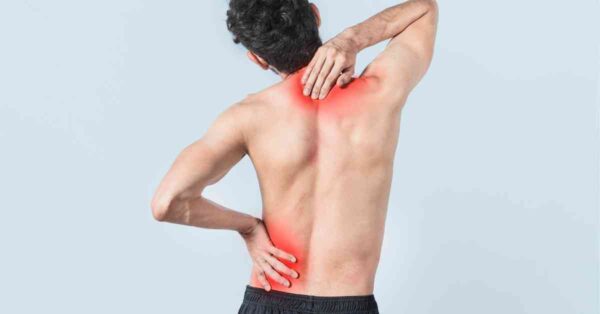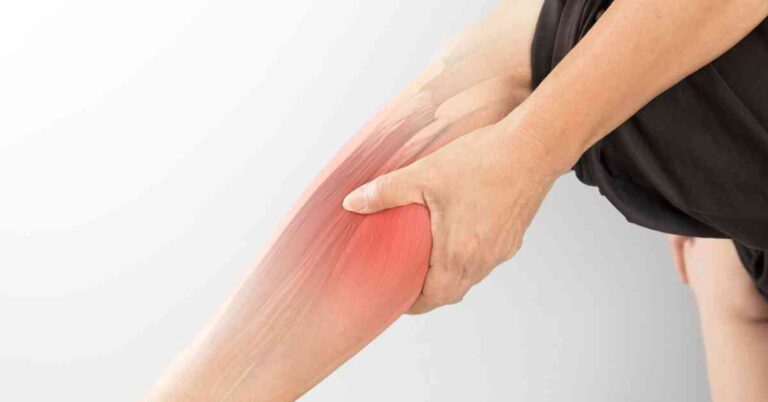Muscle pain is a symptom that can be caused by many different conditions, ranging from simple overuse to complex medical conditions. It can be acute or chronic, mild or severe, and can affect any body part. Muscle pain is a common experience that a variety of factors can cause. This article will discuss what muscle pain is, why it occurs, how it develops, the different types of muscle pain, risk factors, diagnosis, and treatment options.
What is Muscle Pain?
Muscle pain, also known as myalgia, is a sensation of discomfort or pain in the muscles. It can be caused by tension, overuse, injury, or medical conditions that affect the muscles. The severity of muscle pain can range from mild to severe, and it can be temporary or chronic.
Why Muscle Pain Occurs?

Muscle pain can be due to various reasons, such as overuse, tension, strain, or trauma. The body’s natural response to muscle damage is to send blood to the affected area to promote healing, which can cause swelling and additional pain. When the muscle tissue is damaged, it becomes inflamed, which can cause pain, stiffness, and soreness.
Muscle pain can develop gradually or suddenly, depending on the cause. It usually develops over time due to repetitive strain or overuse, or it can occur suddenly due to a traumatic injury. Other symptoms, such as stiffness, weakness, and fatigue, can accompany muscle pain.
Different Types of Muscle Pain
There are different types of muscle pain, depending on the cause and severity. Some of the most common types of muscle pain include:
- Tension Myalgia – This muscle pain is caused by muscle tension, often due to stress, poor posture, or repetitive movements.
- Fibromyalgia – This chronic condition causes widespread muscle pain and tenderness, along with fatigue and sleep disturbances.
- Myofascial Pain Syndrome – This type of muscle pain is caused by trigger points in the muscles, which are tight bands of muscle that can cause pain and stiffness.
- Polymyalgia Rheumatica – This condition causes muscle pain and stiffness, particularly in the shoulders, neck, and hips.
- Delayed Onset Muscle Soreness (DOMS): This type of muscle pain occurs after exercise or physical activity and is characterized by stiffness, soreness, and pain in the affected muscles. It typically develops within 24-48 hours after the activity and lasts several days.
- Ischemic Compression: This type of muscle pain is caused by reduced blood flow to the affected area. It is often due to tight muscles or trigger points and is characterized by a dull, aching pain relieved by pressure.
- Neuralgia: This type of muscle pain is caused by nerve damage or irritation and can cause burning or shooting pain in the affected area. Neuralgia can be caused by conditions such as sciatica or carpal tunnel syndrome.
- Metabolic Myopathies: This is a group of rare genetic disorders that affect the metabolism of the muscles, leading to muscle pain, weakness, and fatigue. Examples of metabolic myopathies include McArdle disease and Pompe disease.
- Rhabdomyolysis is a rare but severe condition that occurs when muscle tissue breaks down and releases harmful substances into the bloodstream. It can cause severe muscle pain, weakness, and dark urine and can be caused by trauma, drug use, or extreme exercise.
Risk Factors
Several risk factors may increase the likelihood of developing muscle pain. These include:
- Overuse or repetitive motions: Repetitive or prolonged use can increase the risk of muscle strain and injury. It commonly occurs in athletes, manual laborers, or individuals performing repetitive work tasks.
- Poor posture or body mechanics: Poor posture or body mechanics can strain muscles excessively, leading to tension and pain. Generally caused by sitting or standing for prolonged periods, carrying heavy objects, or using improper lifting techniques and develops over a long period.
- Sedentary lifestyle: A sedentary lifestyle, with little physical activity or exercise, can cause muscle weakness and stiffness, increasing the risk of muscle pain.
- Lack of flexibility or mobility: A lack of flexibility or mobility can increase the risk of muscle strain and injury. It is often caused by not stretching before physical activity or spending too much time in one position, such as sitting.
- Stress and tension: Emotional stress can cause muscle pain. Factors include anxiety, depression, or other emotional or psychological factors.
- Aging: As the body ages, the muscles can become weaker and less flexible, increasing the risk of muscle strain and injury.
- Medical conditions: Certain medical conditions increase the risk of muscle pain. These include fibromyalgia, myositis, and polymyalgia rheumatica.
Chronic muscle pain

Chronic muscle pain is a type of pain that persists for an extended period, typically longer than three months. Chronic muscle pain can be dull, aching pain that may inflict stiffness, weakness, and fatigue. The underlying causes of chronic muscle pain can be complex and multifactorial. The most common causes of chronic muscle pain include:
- Fibromyalgia: This chronic condition causes widespread muscle pain and tenderness, along with fatigue and sleep disturbances.
- Myofascial pain syndrome: This type of chronic muscle pain is caused by trigger points in the muscles, which are tight bands of muscle that can cause pain and stiffness.
- Polymyalgia rheumatica: This condition causes muscle pain and stiffness, particularly in the shoulders, neck, and hips.
- Chronic fatigue syndrome: This condition causes severe fatigue and muscle pain, along with other symptoms such as headache, cognitive dysfunction, and sleep disturbances.
- Rheumatoid arthritis is an autoimmune condition that can cause chronic joint and muscle pain.
- Injuries or trauma: Chronic muscle pain can also be caused by past injuries or trauma to the muscles, such as a strain or tear that did not fully heal.
Diagnosis
A healthcare provider will perform a physical exam and review the patient’s medical history to diagnose muscle pain. They may also order diagnostic tests, such as blood, imaging, or electromyography (EMG), to assess muscle function and nerve activity.
Treatment Options for Muscle Pain
There are several treatment options for muscle pain, depending on the underlying cause and severity. Some of the most common treatment options include:
- Rest: Resting and immobilizing the affected area can help reduce inflammation and allow the muscles to heal. Avoid activities that aggravate the pain or use supportive devices such as braces or splints.
- Ice or heat therapy: Applying ice or heat to the affected area can help to reduce inflammation and alleviate pain. Ice is typically used for acute injuries or inflammation, while heat is often used for chronic muscle pain.
- OTC pain relievers, such as acetaminophen or nonsteroidal anti-inflammatory drugs (NSAIDs). These standard go-to medications can help to alleviate pain and reduce inflammation. Following the recommended dosage and not exceeding the maximum daily dose is essential.
- Physical therapy to improve strength, flexibility, and mobility: Physical therapy can help to improve muscle strength and flexibility, reduce pain, and prevent future injury. A physical therapist can develop a personalized treatment plan that may include exercises, stretches, and other therapeutic modalities.
- Massage therapy or trigger point injections: Massage therapy can help to relax tight muscles and relieve pain. Trigger point injections involve injecting a medication into specific muscle trigger points to alleviate pain and reduce tension.
- Acupuncture: Acupuncture is an alternative therapy which involves the insertion of thin needles into specific spots on the body may relieve pain and promote healing.
- Cognitive-behavioral therapy (CBT): CBT can help individuals with chronic muscle pain to manage their pain and improve their quality of life by addressing psychological factors that may contribute to their pain.
- Lifestyle changes: Regular exercise, maintaining good posture and body mechanics, practicing stress management techniques, and maintaining a healthy diet can help manage chronic muscle pain.
- Prescription medications, such as muscle relaxants or opioid pain relievers: In some cases, prescription medications may be necessary to manage severe muscle pain. Muscle relaxants can help to alleviate muscle spasms and tension, while opioid pain relievers can be used for short-term pain relief under close medical supervision.
- Surgery: Surgery may be necessary in cases where muscle damage is severe, such as in the case of a torn muscle or tendon.
Prevention
Several strategies can be employed. These include:
- Engaging in regular exercise and stretching to improve muscle strength and flexibility.
- Practicing good posture and body mechanics to reduce the risk of overuse injuries.
- Taking frequent breaks and reduce prolonged periods of sitting or standing to avoid muscle fatigue.
- Staying hydrated and maintaining a healthy diet helps promote muscle health.
- Managing stress and anxiety through relaxation techniques, such as deep breathing or meditation.
Conclusion
Muscle pain is a common experience caused by various factors, ranging from overuse to complex medical conditions. It can be acute or chronic, mild or severe, and can affect any body part. Understanding the causes, types, and treatment options for muscle pain can help individuals manage and prevent this condition. If you are experiencing muscle pain, you should consult a healthcare provider to determine the underlying cause and develop an appropriate treatment plan. Individuals can improve their overall health and quality of life by taking steps to prevent and manage muscle pain.
find more awesome stories on the blog.
References:
- “Muscle Pain” – National Institute of Arthritis and Musculoskeletal and Skin Diseases (NIAMS) – https://www.niams.nih.gov/health-topics/muscle-pain
- “Chronic Pain” – National Institute of Neurological Disorders and Stroke (NINDS) – https://www.ninds.nih.gov/Disorders/All-Disorders/Chronic-Pain-Information-Page
- “Muscle Pain: Diagnosis and Treatment” – American Family Physician – https://www.aafp.org/afp/2011/0101/p43.html
- “Muscle Pain and Fibromyalgia” – Centers for Disease Control and Prevention (CDC) – https://www.cdc.gov/arthritis/basics/fibromyalgia.htm
- “Chronic Pain Management” – American Academy of Pain Medicine – https://www.painmed.org/patient-center/chronic-pain-management/
- “Muscle Pain: Understanding its Mechanisms and Management Strategies” – European Journal of Pain – https://www.ncbi.nlm.nih.gov/pmc/articles/PMC5794269/
- “Muscle Pain: A Review” – Journal of Internal Medicine – https://onlinelibrary.wiley.com/doi/abs/10.1111/joim.12530




